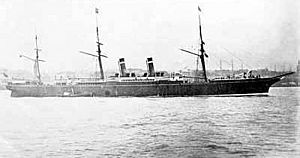RMS City of Chester facts for kids
 |
|
Quick facts for kids History |
|
|---|---|
| Name | RMS City of Chester |
| Owner | |
| Route | Liverpool–New York |
| Builder | Caird & Company, Greenock, Scotland |
| Yard number | 171 |
| Launched | 29 March 1873 |
| In service | 10 July 1873 |
| Out of service | February 1893 |
| Fate |
|
| General characteristics | |
| Tonnage | 4,566 GRT |
| Length | 444 ft 6 in (135.48 m) |
| Beam | 44 ft 2 in (13.46 m) |
| Depth | 34 ft 7 in (10.54 m) |
| Propulsion |
|
| Sail plan | Full-rigged ship |
| Speed | 15 knots (28 km/h; 17 mph) |
| Capacity | 1,515 passengers |
The RMS City of Chester was a large British passenger ship. It was a steamship that traveled across the Atlantic Ocean. This ship sailed from 1873 until 1898, carrying many people between continents.
Contents
Building a Giant Ship
The City of Chester was built in Greenock, Scotland. A company called Caird & Company built it for the Inman Line. When it was launched on March 29, 1873, it was the biggest passenger ship in the world.
This ship weighed 4,566 tons. It held the title of "largest passenger ship" for almost a year. Another ship, the 5,000-ton Britannic, took its place in February 1874.
How the Ship Moved
The City of Chester used a powerful steam engine. This engine had 850 horsepower. It turned a single propeller, which was 21 feet wide.
The ship also had three masts. This meant it could use sails, like a Full-rigged ship. During its test runs, sailing from the Clyde to the Mersey, it could go faster than 15 knots (about 17 miles per hour).
Life Onboard
The City of Chester was 444 feet long and 44 feet wide. It could carry more than 1,500 passengers.
- 125 passengers traveled in first class.
- 80 passengers were in second class.
- 1,310 passengers traveled in steerage. Steerage was a more basic area for people who paid less.
Fancy Features for First Class
First-class passengers enjoyed many luxurious things. They had a fancy saloon (a large room) with walls made of walnut wood. This room also had a piano and a library.
There was a special room called a "Ladies Boudoir" just for women. Passengers could also visit a smoking room and a barber-shop. The ship even had separate bathrooms for ladies and gentlemen with marble baths that used sea-water.
Steerage Accommodation
In the front part of the ship, steerage passengers slept in bunks. These were simple beds stacked one above another.
Journeys and New Names
The City of Chester mainly sailed between Liverpool, England, and New York, USA. It also stopped in Queenstown, Ireland. Its first journey was on July 10, 1873.
Changing Owners
In February 1893, the Inman Line was bought by the American Line. The ship's name was changed to Chester. Its first trip under its new owners was from New York to Southampton, England, on March 4, 1893.
Serving the Government
In 1898, the ship was sold to the United States Government. It was renamed Sedgwick. During the Spanish–American War, it served as a transport ship for the U.S. Army.
In March 1900, a very important person, the Secretary of War Elihu Root, traveled on the Sedgwick. He went to Havana, Cuba, to talk with General Leonard Wood, who was in charge there.
Final Years
In 1903, the ship was sold to an Italian shipping company. It was renamed Arizona. Then, in 1906, its name changed again to Napoletano. Finally, in 1907, the ship was taken apart for scrap in Italy.

